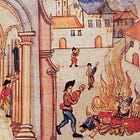By Brad Isbell
The weeks before traditional Easter are when the human desire for the visual, sensual, and tangible is most evident in Christian churches. Pastors often complain of the workload that accompanies special services, as many churches depart from normal, simpler patterns. This is also the time when Protestant churches most closely resemble Roman churches.
The two great issues of the Reformation were (or should have been) worship and salvation doctrine, as Calvin asserted in The Necessity of Reforming the Church:
If it be inquired, then, by what things chiefly the Christian religion has a standing existence amongst us, and maintains its truth, it will be found that the following two not only occupy the principal place, but comprehend under them all the other parts, and consequently the whole substance of Christianity: that is, a knowledge, first, of the mode in which God is duly worshipped; and, secondly, of the source from which salvation is to be obtained. When these are kept out of view, though we may glory in the name of Christians, our profession is empty and vain.
Confessional Reformed churches have always had a clear and biblical position on images, but their commitment to the practical implications of this position has often been weak. And no wonder. As our friend D.G. Hart once said (referring mainly to the unpopularity of Second and Fourth Commandments restrictions), “Being Reformed is just hard.”
The recent, primarily cultural and political outrage over a ridiculous 90-foot-tall Hindu statue in Texas (where we’ve heard that everything is bigger) prompted us to post this on X:
Sorry, but the 2nd Commandment suggests that a 6-foot statue of a Kenny Loggins lookalike purported to represent the Second Person of the Trinity is as (if not more) offensive than a self-parodying 90-foot Hindu idol. When is the march on South Bend to deface "Touchdown Jesus"?1
Here’s a visual aid for you youngsters who don’t remember Mr. Loggins:
Can we easily grasp why images are prohibited? No, we have to take it on faith, not by sight and experience, that the Law of God is good...and good for us. The Law is spiritual, and in our flesh we will either misuse it or ignore it. The so-called Third Use of the Law emphasizes the Law as a guide for Christian living and pleasing God. As Christians, we live in the Church—our main context!—and the most important thing we do to please God is to worship him properly and sincerely.
For these reasons, we are far more concerned about Christians’ use of images than we are about the vanity of pagans and worldlings. We expect pagans to do pagan things; we expect Christians to worship in Spirit and according to truth because (unlike the pagans) they have the Spirit and the truth of God’s Word.
Other posts on the Second Commandment:
The 134-foot-tall graven/stone image that overlooks the University of Notre Dame football field.







